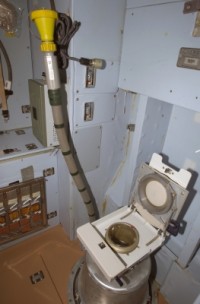Tag archives: International Space Station
Citizen science, astronaut growth, water-flipping physics
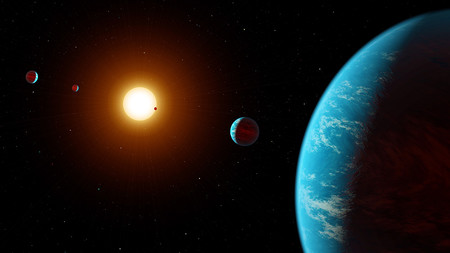
Planet hunting (courtesy: NASA/JPL-Caltech/R. Hurt)
By Michael Banks
This week the American Astronomical Society is meeting in Washington, D.C. At the conference it was announced yesterday that a citizen-scientist project called Exoplanet Explorers had used data from the Kepler mission to detect a new five-planet system.
The 27 authors include, among others, the astronomer and broadcaster Chris Lintott and the particle physicist and broadcaster Brian Cox. Exoplanet Explorers was featured prominently on the Australian TV show Stargazing Live in April and another author on the paper is the Australian TV presenter Julia Zemiro, who is affiliated with the Australian Broadcasting Corporation. You can read the paper here. (more…)
View all posts by this author | View this author's profile
Star Wars fact or fiction, Wikipedia editor in space, stellarator tour
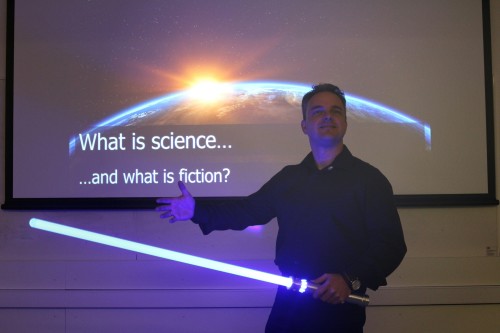
Fact and fiction: Carsten Welsch. (Courtesy: Cockcroft Institute)
By Hamish Johnston
What is it about Star Wars that captivates the imaginations of physicists? Earlier this week Carsten Welsch, who is head of physics at the University of Liverpool and head of communication for the nearby Cockcroft Institute, gave a presentation called “Physics of Star Wars” to an audience of hundreds of secondary school children, undergraduate and PhD students and university staff.
View all posts by this author | View this author's profile
Meteoroid seen from space, Nobel laureates speak their minds on group awards and keeping up with technology
By Hamish Johnston
Fix your eyes on the upper-right portion of the above video and pay particular attention about seven seconds into the footage. You will see a fireball falling through Earth’s atmosphere. The video was taken from the International Space Station by the Italian astronaut and prolific photographer Paolo Nespoli.
Was the fireball a piece of space junk, or perhaps a tiny piece of asteroid? And how fast was it moving? For an analysis of what Nespoli may have seen, go to: “The backstory: Paolo spots a meteoroid from the ISS”. There you will also find a fantastic gallery of photographs taken by Nespoli.
View all posts by this author | View this author's profile
She’s the greatest dancer, how to name an element, soccer ball finally orbits Earth
By Hamish Johnston
The award for most bizarre title for a scientific paper goes to psychologist Nick Neave and colleagues at the UK’s Northumbria University and University of Lincoln for “Optimal asymmetry and other motion parameters that characterise high-quality female dance”. The team says it used “a data-driven approach to pinpoint the movements that discriminate female dance quality”. Why, you might ask? “The form and significance of attractive dance, however, has been less well studied, and this limits our understanding of its role in human courtship and partner selection.” The above video is from a previous study by the team about what constitutes a good male dancer.
View all posts by this author | View this author's profile
Putting a bouncy castle in space and other extraterrestrial adventures
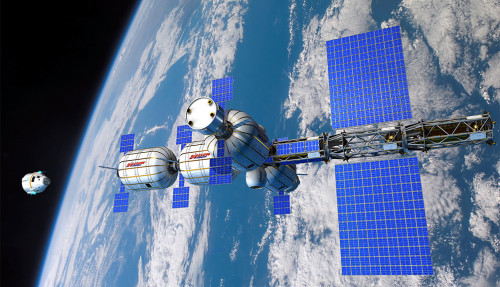
Artist’s impression of a space station comprising four B330 inflatable pods, which are the white cylinders. (Courtesy: Bigelow Aerospace)
By Hamish Johnston
It’s never been a better time to be a space enthusiast, as more and more countries are unveiling space programmes and it seems like a new mission is launched or announced just about every week.
But if you are like me and find the constellation of mission names – the various acronyms, mythical beasts and dead scientists – overwhelming, then the space physicist Chris Arridge has put together “Five human spaceflight missions to look forward to in the next decade” for The Conversation.
Santa and the space station, holiday gift suggestions and no Christmas presents for SUSY
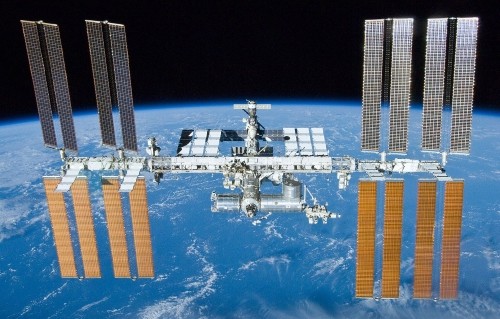
Father Christmas will soon be on his way to the International Space Station. (Courtesy: NASA)
By Hamish Johnston
In this festive edition of the Red Folder, NASA has come up with a great way for youngsters to spot Santa’s sleigh as it streaks across the sky on Christmas Eve. It turns out that Santa hitches a ride with the International Space Station, so you can use NASA’s Spot the Station tool to find out when Father Christmas will be visible above your town. A search on Bristol, UK reveals that Santa will be overhead at 17:21 – perfect for getting the children to bed early.
Hoverboards had looked set to be the hot gift this Christmas, but now the news is full of horror stories about the two-wheeled contraptions bursting into flames. Blogger Sabine Hossenfelder has written a wonderful self-described “rant” about an article in Wired by the physicist Rhett Allain called “You can’t ride a hoverboard without Einstein’s theory of general relativity”. In the true spirit of a Christmas pantomime, Hossenfelder’s response is “Oh yes you can”.
Undeterred, Allain has just posted a new item on Wired that looks at the physics – or lack thereof – in this Christmas’s blockbuster film: “The physics in Star Wars isn’t always right and that’s ok”. I look forward to Hossenfelder’s riposte!
Dismaland physics, laboratory photowalks and more
By James Dacey and Tushna Commissariat
While it may seem as if we Physics World journalists spend our evenings leafing through Newton’s Principia Mathematica or deriving the Dirac equation from first principles, on Wednesday night this week, a few of us visited Dismaland – the pop-up “bemusement park” curated by the elusive British street artist Banksy. Located in the seaside town of Weston-super-Mare – a few miles south-west of the Physics World Bristol HQ – Dismaland offers a darker and more politically motivated alternative to Mickey Mouse and his friends. While our visit was not work-related, there were a few unexpected physics references that we couldn’t help but spot. First we stumbled across “The Astronauts’ Caravan”, a humorous take on the flight simulators used by NASA (see video above).
Created in 2011 by artists and engineers Tim Hunkin and Andy Plant, the outwardly unimpressive-looking theme-park ride is a compact version of the Victorian “haunted swing” illusion. We won’t spoil the magic by explaining the mechanics of the ride here, but you can read this blog by Hunkin where he explains exactly how he and Plant built their spinning caravan and if you can’t visit Dismaland, then watch the video to see what it looks like from the inside.
View all posts by this author | View this author's profile
Hubble at 25, Star Trek selfies on the ISS, Wu-Tang Clan physics and more
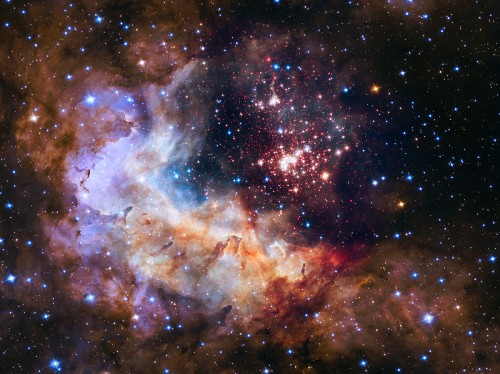
Shine on: Hubble’s official 25 anniversary image of the Westerlund 2 cluster.
(Courtesy: NASA, ESA, (STScI/AURA), A. Nota (ESA/STScI), Westerlund 2 Science Team)
By Tushna Commissariat
25 years ago today, the ESA/NASA Hubble Space Telescope (HST) was launched aboard the Discovery space shuttle and since then, it has changed the face of observational astronomy as we know it; taking millions of people worldwide from their homes to the most distant and far-flung reaches of the universe and the imagination. The telescope has also been instrumental in some of the biggest, Nobel-prize-winning discoveries in physics in the past two decades, including that of the accelerating expansion of the universe. The stunning image above of the giant cluster of nearly 3000 stars dubbed “Westerlund 2” was especially released yesterday to celebrate Hubble’s 25th anniversary. The stellar nursery is difficult to observe because it is surrounded by dust, but Hubble’s Wide Field Camera 3 peered through the dusty veil in near-infrared light, giving astronomers a clear view of the cluster. Once you are done staring in awe at the image, watch the short video below, put together by NASA on the HST’s lifetime.
Night visions, the sky 10 billion years ago and unexplained sounds from around the world
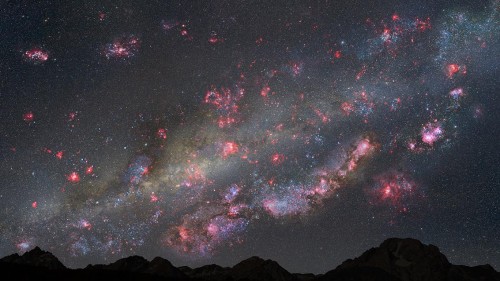
Good old days: the view from an Earth-like planet 10 billion years ago. (Courtesy: NASA/ESA/Z Levay (STScI))
By Hamish Johnston
This week’s Red Folder is inspired by a vision I had last night while I was putting out the garbage bins. I happened to look up at the sky just as the International Space Station (ISS) was travelling over Bristol. It was a very bright and impressive sight as it zipped overhead before disappearing at the eastern horizon. If you happen to be on an arc through northern Europe between Penzance and Poznań, you should also have a great view of the ISS this evening; you can find out when and where to look at the ISS Astroviewer website.
The ISS is one thing that you would definitely not see if you could look at the sky as it was 10 billion years ago – but have you ever wondered what that view would be? Zolt Levay at the Hubble Heritage Information Center has, and the above image is his vision of what the sky would look like from a hypothetical planet within a Milky Way-like galaxy 10 billion years ago. The work was inspired by a new collection of nearly 2000 images of galaxies as they appeared at that time in the history of the universe. Taken by a number of different telescopes including Hubble, “the new census provides the most complete picture yet of how galaxies like the Milky Way grew over the past 10 billion years into today’s majestic spiral galaxies”, according to NASA.
Microwave pockets, space station strife and dreaming of Mars
By Hamish Johnston
The physics of how the contents of a microwaved pastry can become “hotter than the Sun” is the subject of an entertaining and informative blog entry by Ethan Siegel. He looks at the physics of heating “microwave pockets”, those roof-of-your-mouth-scalding savoury treats that appeared on shelves in the 1980s. He explains why the outer portion of a pocket can be extremely hot, while the interior remains frozen – and why pockets often explode when heated through.
Siegel’s been a bit cheeky and republished this entry from 2009, but I suppose it’s timeless and I’m sure you can still buy microwave pockets somewhere! His blog is called Starts With a Bang and the entry is entitled “Throwback Thursday: The physics of hot pockets”.
As the crisis in the Ukraine drags on, scientists are beginning to worry about the effect it could have on scientific collaborations involving Russia and the West. Several websites are reporting that Russia is threatening to ban US astronauts from the shuttles that travel to the International Space Station (ISS). Indeed, the Independent quotes Russia’s deputy prime minister Dmitry Rogozin as saying that it would be possible for Russia to independently operate its portion of the ISS, while the US would not be able to do so. Indeed both toilets on the ISS are Russian, so it could get very messy up there!
